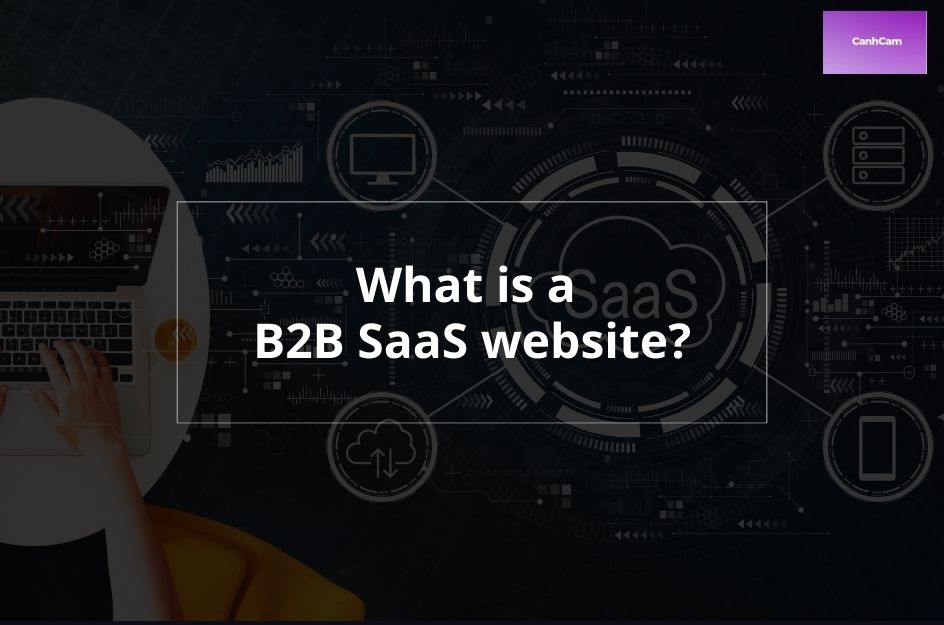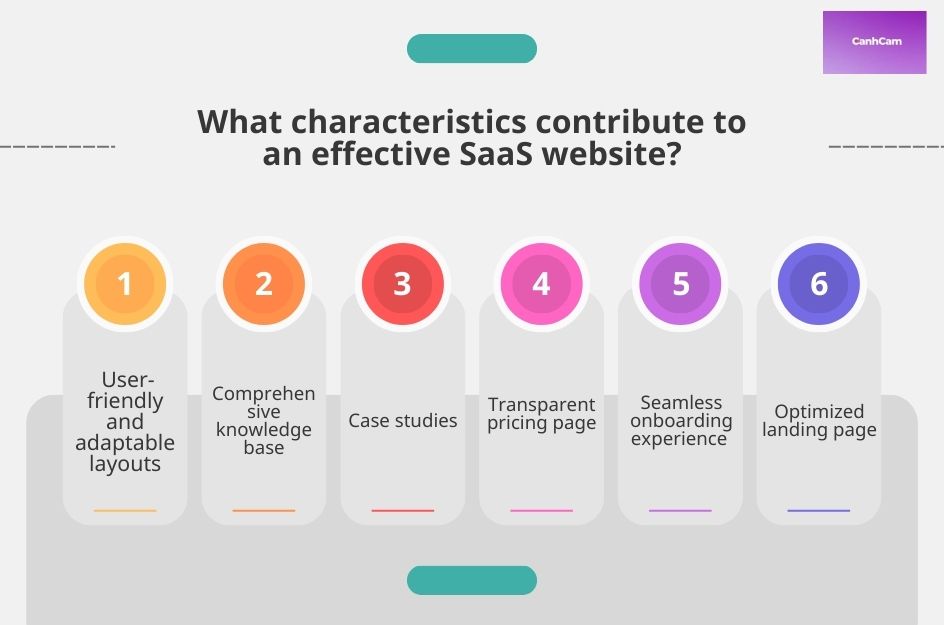In the dynamic digital commerce landscape, B2B SaaS (Software as a Service) companies are at the forefront, offering innovative solutions to streamline operations and enhance productivity for businesses worldwide. However, in this competitive arena, a compelling online presence is not just advantageous; it's essential.
Enter B2B SaaS website design – the strategic fusion of aesthetics, functionality, and user experience tailored specifically to meet the unique demands of B2B clientele.
Crafting a successful B2B SaaS website involves showcasing technical prowess, addressing enterprise-level needs, and fostering trust and reliability.
In this ever-evolving realm, where first impressions often determine business partnerships, the significance of effective website design cannot be overstated. Ready to elevate your B2B SaaS website to new heights? Let's commence this adventure as companions.
What is a B2B SaaS Website?
A B2B SaaS (Software as a Service) website is an online platform that provides tailored software solutions for businesses' operational requirements. These websites offer cloud-based applications and services accessible through subscriptions, catering to diverse industries.
Solutions encompass business management, CRM, project management, marketing automation, collaboration tools, and social media marketing.
B2B SaaS websites empower businesses to streamline operations, boost efficiency, and cut costs compared to conventional software setups.
Leveraging Internet capabilities, they furnish scalable and adaptable solutions, empowering businesses to excel in the contemporary digital environment.
Our service: Best web design agency in Melbourne
What makes B2B SaaS Websites Important?
SaaS products have revolutionized modern business practices by simplifying operations and enabling smaller enterprises to access advanced functionalities at reduced expenses.
Due to this transformation, the need for extensive R&D endeavours to create proprietary software has diminished across numerous sectors.
A proficient SaaS website plays a pivotal role in conveying the value proposition of the SaaS company, showcasing its distinctive product attributes to prospective and current clientele.
Moreover, these websites serve as the principal catalyst for sales within the SaaS realm, particularly in the B2B sector, thereby establishing themselves as the foremost marketing asset for such enterprises.

How to Create SaaS Website Design?
Understanding the importance of crafting a web page for your SaaS business, let's explore some optimal approaches and best practices to achieve this goal.
1. Hook With the Headlines
An important consideration for SaaS website designs is ensuring immediate visitor engagement. It is crucial to emphasize the distinctive features and key selling points right at the start of the homepage.
Communicate how your product stands out from competitors and addresses a specific problem for users. By showcasing value prominently above the fold, you encourage visitors to explore the site further by scrolling down and navigating to other pages.
Employing concise text and a striking headline is an effective strategy to capture visitor attention. Complementing the headline with a brief description or explanation below can maintain visitor interest in your offerings.
Typically, the headline or text can be showcased alongside or overlaid on a prominent header image, providing a glimpse into the business or product. Positioning this content above the fold for a responsive and contemporary website design is crucial.
2. Showcase Products with Visuals
Visual elements play a vital role in a website's effectiveness. Since visitors cannot physically interact with the product, they often rely on imagery or video to gain a deeper understanding. Incorporating appealing visuals or background videos showcasing the product or service can significantly impact their decision-making process.
It is advisable to opt for or craft imagery or videos that align with the business or SaaS products. Engaging visuals can captivate new visitors' attention immediately and increase conversions. Moreover, such elements can enhance the website's appeal over time, potentially attracting more organic traffic.
Consider the effectiveness of a prominent header image or video above the fold in maintaining a minimalist layout and enticing users to explore further. For an interactive layout, leveraging dynamic visual animations for storytelling or implementing sliders can draw immediate attention.
3. Urgent and Bold Call-to-action
Creating exceptional SaaS designs necessitates incorporating compelling CTAs that immediately captivate attention. It's crucial to integrate terms or phrases that convey urgency and prompt visitors to take action, such as signing up, subscribing, or accessing a 'free trial.'
Many websites prominently display strong calls to action (CTAs) on the main image above the fold to encourage immediate action. Placing CTAs prominently across the homepage and simplifying navigation can enhance user engagement. Emphasize CTAs with brand colours, as seen on Slack's website, where the colour matches the background to create familiarity with potential customers.
Alternatively, opt for bright or bold colours like red, green, or yellow against a neutral background to instantly capture attention. Consider selecting colours that complement your logo design. Before proceeding with website development, ensure you have a professionally designed logo that effectively communicates your platform's purpose.
Read more: B2B Ecommerce Website Design - How to Improve Business-to-business Web Design?
4. Use Visual Aids for Clarity
Utilizing images demonstrating product functionality or integrating an explainer video on the homepage can effectively engage visitors for longer durations.
However, incorporating suitable imagery showcasing the product's top features may not be feasible in certain instances. In such cases, it's beneficial to emphasize the key features or benefits that users can gain by subscribing to the solution.
Additionally, including screenshots accompanied by a step-by-step tutorial can effectively illustrate the product's functionality.
Alternatively, featuring an explainer video or showcasing real people using the product can enhance user understanding and engagement. An example is Evernote's website, which features a concise video on the homepage, effectively showcasing the product's offerings.
To enhance visual appeal without using imagery or video:
- Consider employing bold headlines and informative content to highlight features.
- Integrate infographics or geometric shapes for easy skimming.
- Maintain a simple layout with ample white space to prevent clutter.

5. Social Proof
There are various ways to enhance credibility on a website, including:
- Testimonials or Reviews
- Awards or Certifications
- Clients or Company Logos
- Reviews from platforms like TrustPilot, Google, or BBB
- Statistical data
- Genuine feedback received via email
Many SaaS websites utilize a combination of these elements as social proof. However, it's important to avoid overwhelming visitors with excessive details. The website should maintain an authentic and credible appearance to quickly build trust with potential customers. Incorporating reviews from platforms like TrustPilot or BBB (The Better Business Bureau) can also contribute to establishing credibility on the SaaS website.
6. Pricing Page
The pricing page holds significant importance and should be prioritized from the outset of website development. To effectively engage users through good web design, it's essential to feature pricing plans or various options prominently. Typically, SaaS websites include the pricing category in their menu or navigation bar for easy access.
7. Quality Content and Valuable Information
The content displayed on your website plays a crucial role in enhancing your rankings in search engine results and retaining visitors. It's essential to incorporate valuable content on landing pages and your blog to establish authority in the industry by offering insights or information.
Including a blog page featuring articles, videos, or infographics can engage visitors from the moment they arrive on your site. Consider incorporating an FAQ section containing fundamental information about common queries, if feasible. Ensure that essential contact details such as email, phone number, and social media page links are also prominently featured.
What makes a SaaS website Work Well?
Outstanding SaaS websites demonstrate a seamless user experience while efficiently fostering interactions. Here are some supplementary essential elements that enhance customer-friendliness and navigation while also boosting conversion rates.
1. User-friendly and Adaptable Layouts
Ensuring user-friendly and adaptable designs is crucial for all websites and is particularly important for SaaS platforms. Upon visiting a website, users should effortlessly find their desired destinations, whether exploring additional features, reviewing pricing details, or undertaking other actions.
Furthermore, the design must be tailored to function seamlessly across all devices, particularly mobile devices, to guarantee accessibility regardless of the user's chosen device.
By prioritizing these aspects, businesses can enhance customer engagement, improve user experience, and boost sales. Crafting a user-centric experience is a fundamental requirement for every single web page on your site.
2. Comprehensive Knowledge Base
A robust information repository is vital for the success of any SaaS platform. Such complimentary materials should encompass FAQs, informative articles, tutorial videos, and additional aids aimed at helping customers swiftly resolve their queries or issues.
Consider crafting a blog entry detailing the significance and functionalities of your software. Ensuring easy access to such resources will empower prospective customers, instilling in them the assurance required to make a purchase decision on your website.
3. Case Studies
Case studies play a pivotal role in showcasing the worth of your product or service. They serve as authentic customer testimonials, offering real-life illustrations and evidence of your product's effectiveness.
Additionally, they effectively demonstrate the practical applications of your software to potential customers. Presenting success stories from contented customers can effectively highlight your product's value proposition and underscore why it is an excellent option for businesses seeking to streamline their operations.
4. Transparent Pricing Page
It's imperative for a SaaS website to feature a transparent pricing page, enabling customers to effortlessly compare various service tiers and grasp the mechanics of your pricing model.
Potential customers want to know exactly what they get for their money, so providing clear and upfront pricing information is crucial.
A good SaaS website should clearly outline the different pricing tiers, the features in each tier, and any additional costs associated with the service.
This transparency helps build trust with potential customers and makes it easier for them to make an informed decision about whether or not the product is right for their needs.

5. Seamless Onboarding Experience
Another crucial aspect of exceptional SaaS website design involves providing a smooth onboarding experience. This process should be swift and straightforward, enabling customers to familiarize themselves with the platform without requiring extensive technical assistance.
Such seamless onboarding ensures more potential customers remain engaged on the site and successfully utilize the product or service they're signing up for. Additionally, it aids in retaining existing customers by ensuring they have a satisfying and engaging experience.
6. Optimized Landing Page
Optimized landing pages are also essential for a successful SaaS website. Landing pages are often the first point of contact between a potential customer and the product, so they must be well-designed and optimized for conversion.
A good landing page should communicate the product's value proposition, highlight key features and benefits, and provide a clear call-to-action for visitors to sign up or learn more.
Additionally, landing pages should be optimized for SEO to ensure they rank well in search engine results and attract organic traffic.
Conclusion
In conclusion, B2B SaaS website design serves as the gateway to establishing credibility, building relationships, and driving conversions in the competitive world of digital business solutions. As technology evolves and customer expectations shift, staying ahead demands a commitment to refining and optimizing your online presence.
By prioritizing user-centric design, seamless functionality, and clear communication of value propositions, B2B SaaS companies can carve out a distinct identity in their market and cultivate lasting partnerships with their clientele.
Remember, your website isn't just a digital storefront; it's a powerful tool for driving growth and success. Embrace the potential of B2B SaaS website design and unlock new possibilities for your business today.

